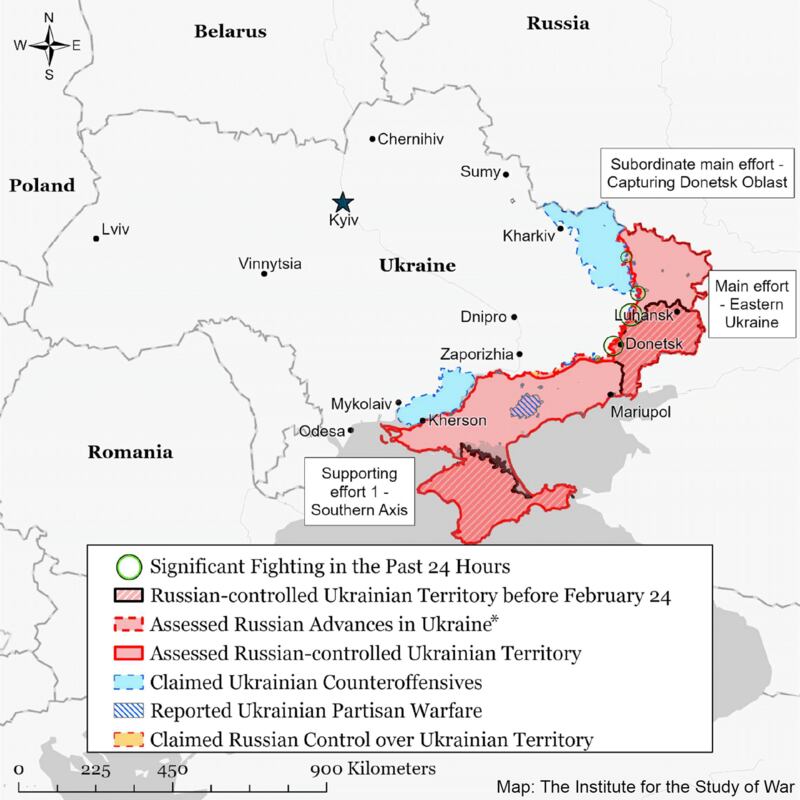Ukraine’s swift recapture of Kherson, whose abandonment was only announced publicly by the Russians on Wednesday, sets the stage for a critical phase in the war. An autumn of territorial concessions by Moscow leaves and inflict on the invaders a catastrophic political defeat.
At first, it will be necessary for Ukraine to consolidate its gains in and around Kherson, restore power and other utilities, although there is no serious land threat, now that the retreating Russian forces have blown up so much of the principal Antonivsky road and rail bridges that led into the city several hundred metres across the Dnipro River, the barrier on which the Russians now hope to rely.
Of greater immediate concern is the blowing up of part of the Nova Kakhovka dam, as revealed by satellite images, which will further disrupt already strained power supplies and whose downstream impact is uncertain. The effect, though, is expected to be felt worst on the Russian-occupied south of the river – an act that the Geneva conventions warn can be considered a war crime if it leads to “consequent severe losses among the civilian population”.
Antonivsky and Nova Kakhovka are the only crossings of the Dnipro south of Ukrainian-held Zaporizhzhia city, and without them (or even if they were intact) it will be difficult and dangerous for Ukrainian counterattacks to press ahead there. A glance at the map has led an increasing number of commentators, western and Russian, to suggest an advance in the Zaporizhzhia sector towards Melitopol and Berdyansk is the obvious next point of counterattack.
Russia attacks Ukraine’s Kharkiv in ‘most powerful’ strike since start of war
Israeli businessman buys Ukrainian property formerly owned by Seán Quinn
Ukrainian commander’s final dispatch: ‘I had hoped my service and sacrifices would be enough, but they haven’t’
The Baltics are rapidly becoming a cauldron of EU growth when other parts of Europe are stagnating
Ukraine’s success in Kherson – and make no mistake, forcing Russia out with minimal civilian casualties is a major achievement – was a victory achieved by smashing the Russian supply chain. That was concluded with US Himars artillery, aided almost certainly by good local intelligence to pinpoint command and logistics centres on the ground. But critical also was favourable geography – the isolated position of Kherson on the west of the Dnipro.
The Zaporizhzhia front to the east is essentially a straight line across open country that has not moved for months, so in theory Moscow’s forces should be well dug in. Russia’s other advantage is that it has called up what it says are 300,000 conscripts, a third of whom are at the front. But manpower alone does not guarantee success – the new recruits are often placed ahead of more seasoned troops, with reports of newbies being hurled into battle with minimal training, bad equipment – only two of seven armoured vehicles would start without pushing – and poor pay.

At the same time, Russia’s tactical approach has so far been so inflexible that Kyiv will feel confident it can apply the same trick, to hit invaders in the rear so their forward line cannot fight effectively. Now all of Kherson province south of the Dnipro, up to Crimea, is in the 50-mile range of the Himars rockets.
A notable posting last week by a Russian military blogger, Military Informant, conceded that Russia’s position on Kherson had been hopeless since the summer, and that it was only possible to bring forward a tenth of the required supplies. The writer then complained about Russia’s “archaic logistics systems” with long lead times, insufficient high-precision weaponry and, interestingly, “centralised depots”, which present attractive targets for Ukrainians to disrupt.
Against this backdrop it was surprising that last week Gen Mark Milley, the US’s top military officer, talked up “diplomatic solutions” to the near nine-month war and argued that the Ukrainians had only managed to fight the Russians “to a standstill”. Concerns about a first World War-style deadlock between the two countries do not appear to be matched by the autumn’s developments on the ground in Kherson and, before that, in the liberations near Kharkiv.
Gen Milley’s position appears to be an outlier in the Biden administration, which also announced a further $400 million in weapons supplies last week and has been buoyed up by better than expected midterm election results. The US national security adviser, Jake Sullivan, talked up the Kherson victory on Friday and said “If Ukraine chose to stop fighting and give up, it would be the end of Ukraine” – and, for now, Kyiv appears to retain US and western support to fight on into next year.
The winter weather clearly makes the situation more complicated for both sides, although the ground is expected to freeze, increasing the opportunities for manoeuvre, which will help the Ukrainian counterattackers. Last month Lloyd Austin, the US defence secretary, said he expected fighting to carry on throughout the cold season. Ukraine, with the wind in its sails, will want to show it can press on further, before there is fresh talk of deadlock.













